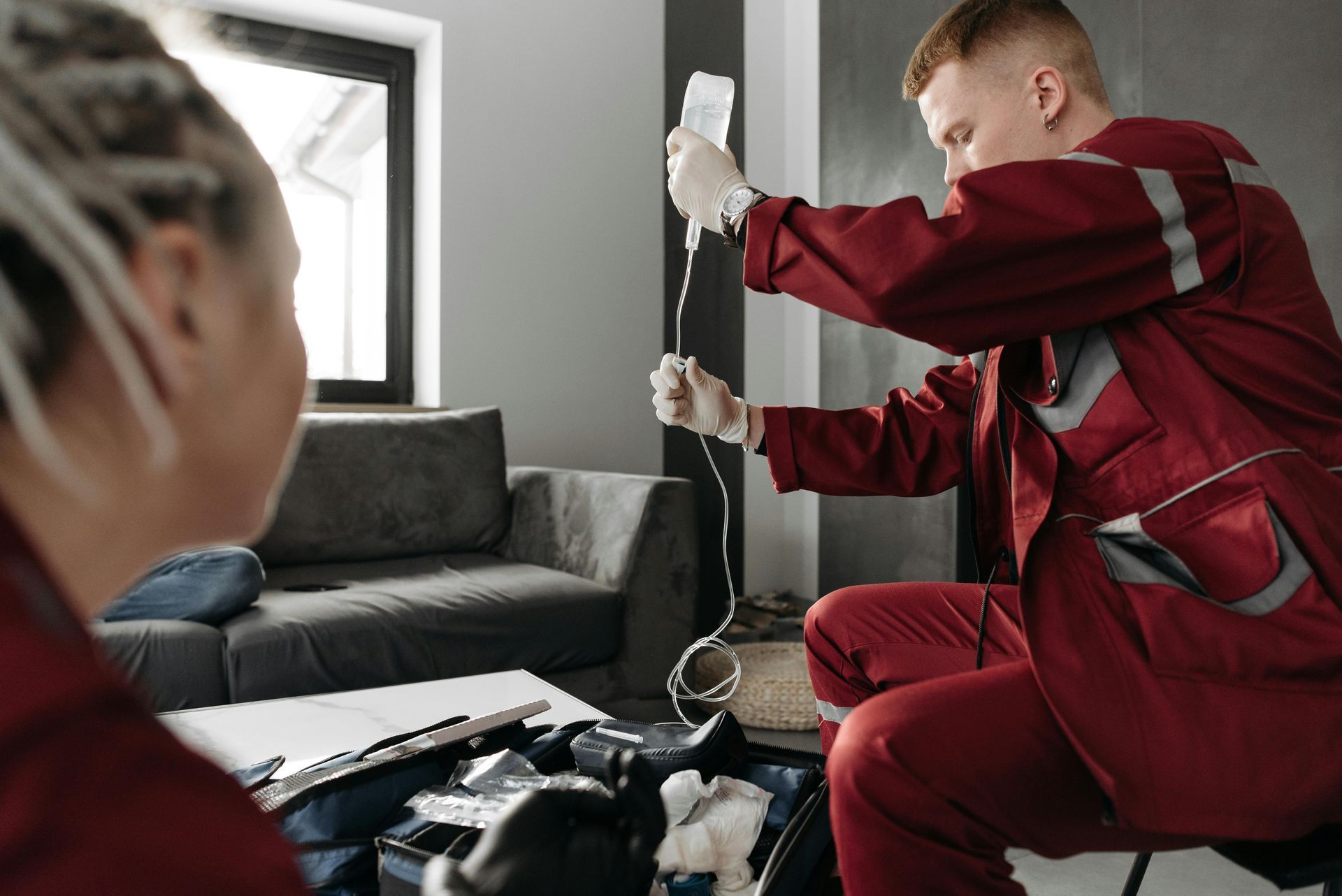Why Choose In-Clinic IV Therapy Over Mobile Service

Medically reviewed by Micaela Strevay, FNP-C, PMHNP-BC
Table of Contents

Intravenous (IV) therapy has gained prominence in recent years for its ability to hydrate, replenish nutrients, and deliver medications directly into the bloodstream. As more patients explore this treatment option, the choice between in-clinic IV therapy and mobile service becomes essential. In this article, we will delve into understanding IV therapy, compare the two service formats, and highlight the advantages of choosing in-clinic therapy, all while considering potential drawbacks of mobile services.
Understanding IV Therapy
What is IV Therapy?
IV therapy involves the administration of fluids, vitamins, minerals, or medications through a catheter directly into a patient's bloodstream. This method bypasses the digestive system, ensuring rapid absorption and immediate effect. It's commonly used for dehydration, nutrient replenishment, and administering medications, offering a versatile solution for various health needs.
Often performed in clinical settings, IV therapy allows healthcare professionals to monitor patients closely and make adjustments based on real-time health indications. The key components of an IV setup include the intravenous solution, tubing, and a puncture site, typically in the arm or hand.
The Importance of IV Therapy
IV therapy is important for several reasons. First and foremost, it offers quick relief for dehydration, especially in critical situations like heatstroke or postoperative recovery when patients may struggle to consume adequate fluids orally. Additionally, IV therapy can deliver essential vitamins and minerals that support overall wellness.
Furthermore, it can effectively address certain medical conditions such as migraines and chronic fatigue syndrome, providing symptomatic relief that enhances a patient's quality of life. Ultimately, IV therapy’s quick delivery method makes it a sought-after option for wellness and recovery.
Comparing In-Clinic IV Therapy and Mobile Service
The Concept of In-Clinic IV Therapy
In-clinic IV therapy refers to treatments administered in a healthcare facility, such as a hospital or specialized clinic. This model offers numerous benefits, including direct access to medical professionals trained to deal with various medical scenarios. Patients receive more comprehensive attention in a controlled environment, ensuring that any unexpected reactions can be addressed immediately.
Moreover, in-clinic services often offer a broader range of IV therapies tailored to individual health needs, which may not be available through mobile services. Such facilities are typically equipped with a variety of IV solutions, along with the knowledge to customize mixtures based on each individual’s condition.
The Concept of Mobile IV Therapy Service
Mobile IV therapy is a relatively new concept where certified professionals administer IV therapy in the comfort of your home or preferred location. This service is convenient, particularly for those with busy schedules or mobility issues, as it eliminates the need to travel to a medical facility.
Patients can enjoy personalized care in a relaxed environment, often opting for treatments specifically designed to address their immediate needs, such as hangover relief or fatigue recovery. However, the convenience of mobile services does come with its considerations that may not always align with optimal health practices.
Advantages of In-Clinic IV Therapy
Professional Medical Supervision
One of the major advantages of in-clinic IV therapy is the presence of professional medical supervision. Trained healthcare providers monitor patients during the treatment process, ensuring their safety by quickly addressing any adverse reactions or complications.
This level of supervision is particularly vital for patients with underlying health conditions, where the risk of complications may be heightened. Immediate access to additional medical support ensures peace of mind for both patients and providers.
Access to Advanced Medical Equipment
In-clinic settings typically have access to advanced medical equipment and technology. This includes not only IV administration tools but also vital sign monitoring equipment. In emergencies, healthcare providers can efficiently switch gears to provide additional care, such as oxygen or medication delivery.
Assurance of Sterile Environment
Infections related to IV therapy can be a significant concern for patients. In-clinic therapy takes place in a controlled and sterile environment, reducing the risk of contamination during the procedure. The stringent protocols followed in healthcare facilities ensure that hygiene standards are upheld, which is pivotal for patient safety.
Potential Drawbacks of Mobile IV Therapy Services
Concerns About Professional Supervision
While mobile IV services offer convenience, they may lack the extensive professional supervision found in clinics. Although licensed practitioners provide the treatment, the absence of immediate access to multi-disciplinary medical teams can be a disadvantage.
This limitation can be particularly alarming for patients with pre-existing health conditions, where an unexpected complication could arise. The potential for inadequate emergency response poses risks that should be considered carefully.
Limitations in Equipment and Resources
An additional drawback of mobile IV therapy is the limitations concerning equipment and resources. Mobile service providers may not have access to the same array of IV solutions, medical technology, or support that a clinical environment can offer.
This lack of access can restrict the variability and specialization of treatments patients receive, making it crucial to evaluate personal health needs before opting for mobile services.
Questions About Sterility and Hygiene
The sterility of mobile IV therapy can also come into question. While reputable providers maintain hygiene protocols, treating patients in non-clinical locations introduces risks of environmental contamination. Issues such as storage conditions for IV solutions and the handling of equipment can be less rigid compared to clinical environments.
Making the Right Choice for Your Health
Factors to Consider When Choosing IV Therapy
When deciding between in-clinic IV therapy and mobile services, consider several factors. These may include your current health status, the urgency of treatment, and your comfort level with the location of care. Evaluate how pressing your needs are; if they are critical, in-clinic therapy might be more appropriate.
Additionally, consider your preferences related to convenience versus the need for professional supervision and resources. Weighing these factors can help you make a more informed decision tailored to your circumstances.
Why In-Clinic IV Therapy Might Be the Better Option
Ultimately, in-clinic IV therapy often emerges as the more advantageous choice for those seeking comprehensive care. The combination of professional oversight, access to advanced medical equipment, and a sterile environment significantly enhances patient safety and treatment efficacy.
As a vital aspect of health and wellness, understanding the nuances between in-clinic and mobile services can guide you in making the best decision for your health needs. Prioritizing your safety and ensuring effective treatment should always be at the forefront of your choices.





